Themed collection Editor’s Choice: Thermoelectric nanostructures

2D layered all-inorganic halide perovskites: recent trends in their structure, synthesis and properties
Here, we discuss the recent development in all-inorganic 2D layered halide perovskites highlighting their crystal structure, synthesis, transformations, and optical, thermoelectric, magnetic, and catalytic properties.

Nanoscale, 2020,12, 21094-21117
https://doi.org/10.1039/D0NR06138G
2D and 3D nanostructuring strategies for thermoelectric materials
Recent progress and research trends for 2D and 3D nanostructures in thermoelectric applications.
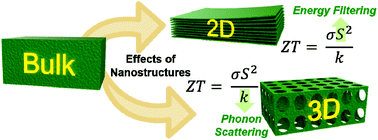
Nanoscale, 2019,11, 19684-19699
https://doi.org/10.1039/C9NR07406F
Origins of pressure-induced enhancement in thermal conductivity of hybrid inorganic–organic perovskites
The thermal conductivity of hybrid perovskites can be tuned by more than an order of magnitude through application of hydrostatic pressure, thus emphasizing the potential in enhancing their efficiencies in photovoltaic applications.

Nanoscale, 2021,13, 685-691
https://doi.org/10.1039/D0NR08776A
Spatially resolved thermoelectric effects in operando semiconductor–metal nanowire heterostructures
The thermoelectric properties of a nanoscale germanium segment connected by aluminium nanowires are studied using scanning thermal microscopy.

Nanoscale, 2020,12, 20590-20597
https://doi.org/10.1039/D0NR05504B
Graphene inclusion induced ultralow thermal conductivity and improved figure of merit in p-type SnSe
Polycrystalline SnSe sample with graphene embedded in realized the enhancement of phonon scattering and achieved ultralow thermal conductivity.
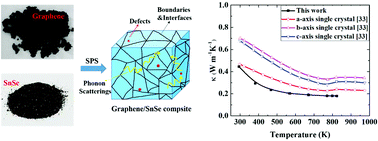
Nanoscale, 2020,12, 12760-12766
https://doi.org/10.1039/D0NR01949F
High thermoelectric power-factor composites based on flexible three-dimensional graphene and polyaniline
Uniform distribution of strong π–π interfaces between PANI and graphene across the whole macrostructure enhances the thermoelectric properties of hybrid thermoelectric nanocomposites.

Nanoscale, 2019,11, 6552-6560
https://doi.org/10.1039/C8NR10537E
Molecular-scale thermoelectricity: as simple as ‘ABC’
If the Seebeck coefficient of single molecules or self-assembled monolayers could be predicted from measurements of their conductance–voltage (G–V) characteristics alone, then the difficult experimental task of measuring their thermoelectric properties could be avoided.

Nanoscale Adv., 2020,2, 5329-5334
https://doi.org/10.1039/D0NA00772B
Nanostructured monoclinic Cu2Se as a near-room-temperature thermoelectric material
Nanostructured monoclinic Cu2Se with low thermal conductivity shows a figure of merit of 0.72 at 380 K.
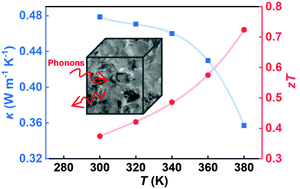
Nanoscale, 2020,12, 20536-20542
https://doi.org/10.1039/D0NR05829G
Isolated flat bands and physics of mixed dimensions in a 2D covalent organic framework
Rational design of 2D-COFs results in an isolated flat band, and quasi-1D and quasi-0D physics in a single 2D system.

Nanoscale, 2020,12, 20279-20286
https://doi.org/10.1039/D0NR04428H
Revealing the origin of dislocations in Pb1−xSb2x/3Se (0 < x ≤ 0.07)
Dislocations could be originated from the nanostructures in Pb1−xSb2x/3Se (0 < x ≤ 0.07), which is important to defect engineering in thermoelectrics.

Nanoscale, 2020,12, 19165-19169
https://doi.org/10.1039/D0NR05382A
Electronic conductance and thermopower of single-molecule junctions of oligo(phenyleneethynylene) derivatives
OPE3 derivatives with tailored substituents are promising substrates for thermoelectric characterization using STM in single-molecule junctions with gold electrodes.

Nanoscale, 2020,12, 18908-18917
https://doi.org/10.1039/D0NR04413J
Thermoelectric performance of nanostructured In/Pb codoped SnTe with band convergence and resonant level prepared via a green and facile hydrothermal method
The enhanced thermoelectric performance is achieved in nanostructured SnTe with band convergence and resonant level prepared by a green and facile hydrothermal method.

Nanoscale, 2020,12, 5857-5865
https://doi.org/10.1039/D0NR00495B
Ultra-low thermal conductivity and high thermoelectric performance of two-dimensional triphosphides (InP3, GaP3, SbP3 and SnP3): a comprehensive first-principles study
By performing first-principles calculations combined with the Boltzmann transport equation, we report a comprehensive study of the thermal and thermoelectric properties of monolayer triphosphides InP3, GaP3, SbP3 and SnP3.

Nanoscale, 2020,12, 3330-3342
https://doi.org/10.1039/C9NR08679J
Core–shell nanostructures introduce multiple potential barriers to enhance energy filtering for the improvement of the thermoelectric properties of SnTe
BiCuSeO@SnO2 core-shell nanostructures can introduce multiple potential barriers in SnTe to enhance energy filtering effect.
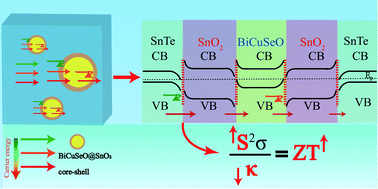
Nanoscale, 2020,12, 1904-1911
https://doi.org/10.1039/C9NR09331A
Atomic-scale tuning of oxygen-doped Bi2Te2.7Se0.3 to simultaneously enhance the Seebeck coefficient and electrical conductivity
The simultaneous enhancement of the Seebeck coefficient and electrical conductivity is achieved in Bi2Te2.7Se0.3 using an ALD-based strategy.

Nanoscale, 2020,12, 1580-1588
https://doi.org/10.1039/C9NR07591G
High-performance thermoelectric silver selenide thin films cation exchanged from a copper selenide template
A high-performance n-type thermoelectric Ag2Se thin film via cation exchange using a low-cost solution processed Cu2Se template.

Nanoscale Adv., 2020,2, 368-376
https://doi.org/10.1039/C9NA00605B
Monolayer SnP3: an excellent p-type thermoelectric material
Monolayer SnP3 is a novel two-dimensional (2D) semiconductor material with high carrier mobility and large optical absorption coefficient, implying its potential applications in the photovoltaic and thermoelectric (TE) fields.
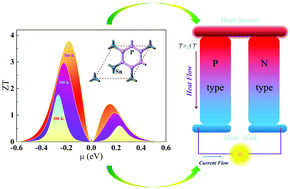
Nanoscale, 2019,11, 19923-19932
https://doi.org/10.1039/C9NR04726C
Monolayer β-tellurene: a promising p-type thermoelectric material via first-principles calculations
Side and top views of monolayer 2D-β-Tellurene with difference charge densities (DCD).
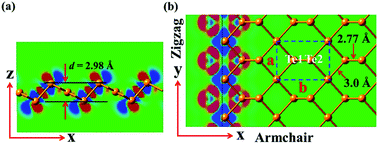
Nanoscale, 2019,11, 18116-18123
https://doi.org/10.1039/C9NR04176A
A honeycomb-like paper-based thermoelectric generator based on a Bi2Te3/bacterial cellulose nanofiber coating
A honeycomb-like paper-based thermoelectric generator for energy harvesting.
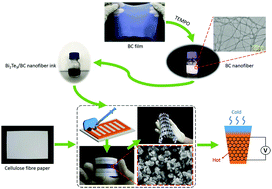
Nanoscale, 2019,11, 17725-17735
https://doi.org/10.1039/C9NR06197E
Integration of multi-scale defects for optimizing thermoelectric properties of n-type Cu1−xCdxFeS2 (x = 0–0.1)
Illustration of integrating multi-scale defects for optimizing the thermoelectric properties of Cu1−xCdxFeS2.

Nanoscale, 2019,11, 17340-17349
https://doi.org/10.1039/C9NR04693C
Magnetically enhancing the Seebeck coefficient in ferrofluids
A thermogalvanic cell containing nanofluids under working conditions.

Nanoscale Adv., 2019,1, 2979-2989
https://doi.org/10.1039/C9NA00109C
Ultralow lattice thermal conductivity induced high thermoelectric performance in the δ-Cu2S monolayer
The δ-Cu2S monolayer exhibits an ultralow κ1 of 0.10 W m−1 K−1 and a high ZT of 1.33 at 800 K.

Nanoscale, 2019,11, 10306-10313
https://doi.org/10.1039/C9NR01501A
Flexible thermoelectric generators with inkjet-printed bismuth telluride nanowires and liquid metal contacts
A nanowire based flexible thermoelectric generator with liquid metal contacts is fabricated by inkjet and spray printing.

Nanoscale, 2019,11, 5222-5230
https://doi.org/10.1039/C8NR09101C
Thermoelectric terahertz photodetectors based on selenium-doped black phosphorus flakes
We here demonstrate terahertz detection activated by photo-thermoelectric effect in selenium-doped black phosphorus flakes.

Nanoscale, 2019,11, 1995-2002
https://doi.org/10.1039/C8NR09060B
Engineering of charge carriers via a two-dimensional heterostructure to enhance the thermoelectric figure of merit
Thermoelectric ZT of n-doped ZrSe2/HfSe2 SLM at room temperature.

Nanoscale, 2018,10, 7077-7084
https://doi.org/10.1039/C7NR09029C
About this collection
Professor Jin Zou (University of Queensland, Australia), Associate Editor for Nanoscale and Nanoscale Advances, introduces his Editor’s Choice collection.
“The development of thermoelectric materials has been considered as a key sustainable solution in dealing with the global energy dilemma by harvesting electricity from waste heat. Nanostructuring is a critical approach to enhance thermoelectric properties and coupled with other strategies, the development of thermoelectric nanostructures has been an active research discipline in exploring high-performance energy materials.
In this online collection, we have selected an array of thermoelectric nanomaterials related research articles and reviews recently published in Nanoscale and Nanoscale Advances, providing informative examples on the design and realization of thermoelectric materials with improved performance through theoretical modelling and/or experiments. In these articles, rich strategies have been demonstrated or proposed to enhance thermoelectric performance. Detailed correlations between observed properties with determined structural and chemical characteristics of thermoelectric materials allow the fundamental understanding of the nature of these materials, which, we hope, may inspire our readers in our wider nanocommunity.”